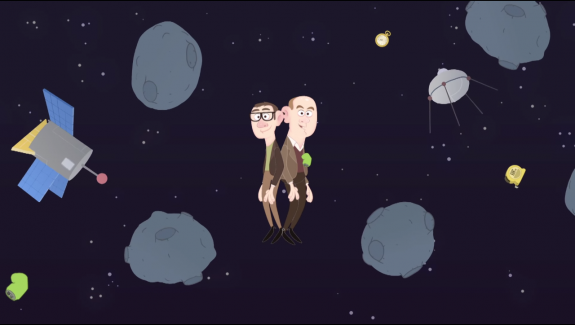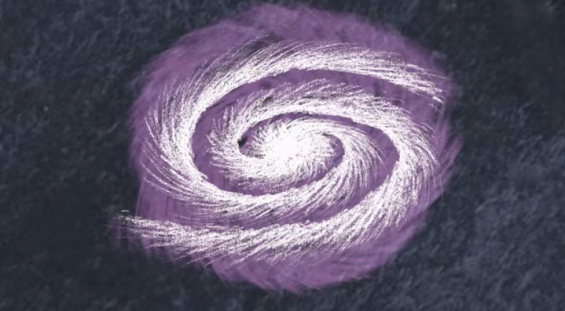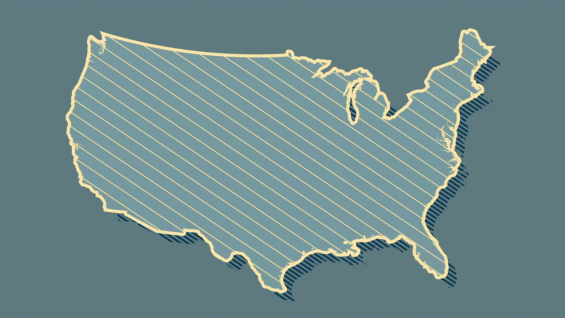
CERN scientists simplify space-time in 3 short videos

Space is where things happen. Time is when things happen. And sometimes, in order to really look at the universe, you need to take those two concepts and mash them together. Space-time is a pretty confounding subject to wrap one’s head around, though, so we asked CERN scientists (and all-around super nerds) Andrew Pontzen and Tom Whyntie to break it down for us. Below, the full three-part series, complete with black holes, space-time diagrams and a load of wibbly-wobbly timey-wimey stuff.
In this first lesson, our hilarious hosts go through the basics of space and time individually, using a flip book to illustrate how we can begin to look at them together.
Light always travels at a speed of 299,792,458 meters per second. But if you’re in motion too, you’re going to perceive it as traveling even faster — which isn’t possible! In this second installment, Pontzen and Whyntie use a space-time diagram to analyze the sometimes baffling motion of light.
In the first two lessons, we dealt with objects moving at constant speeds with straight world line, in space-time. But what happens when you throw gravity into the mix? In this third and final lesson, Pontzen and Whyntie explore what gravity means for space-time — or rather, what space-time means for gravity.
Want to see more of our collaborations with CERN scientists? The beginning of the universe is a great place to start. >>




Great animation, explanation and simplification. Thanks.
One thing I still cannot find an answer to relates to the twin paradox.
If twin A travels at the speed of light, upon her return, she will be younger than twin B, but, from twin A’s perspective, twin B was travelling at the speed of light, how come twin A is not older than?
only 1 of the twins incurred a change in velocity (so an acceleration) from -C speed to +C speed – this is where the magic happens
This might help?
https://en.wikipedia.org/wiki/Twin_paradox
Great videos! Science is at such an exciting time right now, anything scientists can do to include the general public in their findings and inspire young creative thinkers is brilliant.
Eduardo, in your example only one of the twins (Twin A) is travelling at the speed of light. Twin B is being moved away from at the speed of light, which is of little consequence; her speed stays the same as it was before Twin A split. If they both moved at the speed of light for the same amount of time then their ages wouldn’t change relative to one another.
Only one twin experiences acceleration.
I believe that is because regardless of how it looks, the one that is actually modifying space time by moving at the speed of light is the one that exists for the shorter duration. it takes the rest of the universe longer to catch up so more information gets processed.
Then again is space actually compressed by gravity, is mass striated by it or perhaps it’s both. added space would account for both reduced passage of time and apparent shortening of distances in direction of travel.
In the perspective of twin B, yes, twin A is younger. Now in the perspective of twin A, twin B is younger, as you expected! It’s because these two perspectives (frame of reference) are not stationary relative to each other, theyre moving relative to each other, they experience different things! So, daily speaking, (because i dont know about the scienticfic thingy) there can be many frames of references, and we may see one thing in many different ways.
In order to travel at the speed of light one needs to accelerate. Acceleration requires energy. The amount of energy spent depends on the mass of the accelerated object.
In the case of the twin paradox, only twin A has accelerated to the speed of light. Twin B and the rest of the world have not accelerated and are therefore standing stil.
A is accelerating and decelerating while turning around to come back to B.
B is at constant velocity
The twin paradox time occurs because time is relative. As one twin (twin A) moves close to the speed of light, time slows down for that twin. Therefore upon her return, she will be younger than the twin on Earth (twin B). This is taught in Modern Physics where they discuss the Theory of Relativity.
Time is relative and the evidence is objects we carry everyday. For example, for accurate GPS calculations, one must take into account that a satellite’s time is actually slower than our time on Earth!
Because time dilates based on the speed you’re travelling. Twin A is the one actually doing the travelling from Twin B’s frame of reference. Therefore no time has dilated for Twin B, but it has for Twin A (it slowed down, from Twin B’s frame of reference).
But I guess that’s not the full answer. Does anyone have a more complete answer?
That is a very good question. Since all speeds are relative to the observer, no-one can say which is actually static and which moving. We see ourselves as stationary when in fact we are travelling through space at thousands of miles an hour as we orbit the Sun, but the Sun is equally orbiting round the Milky Way galaxy at thousands of miles an hour. In your question in fact they could both be travelling at half the speed of light relative to a point central between them, so they would end up appearing the same age.
Moving on from that, the claim is that nothing can travel faster than light, so lets imagine five points in space, in a straight line:
A B C D E
Now say the Earth is at C and B and D are at the limits of our observation where things appear to be travelling away from us at almost the speed of light. Given that space is roughly evenly spread out, then from point B, A and C appear to be travelling away from them at nearly the speed of light, similarly for points C and E relative to D, that means that relative to us at point C both A and E are travelling at nearly twice the speed of light, and from point A, E is travelling at nearly four times the speed of light. It doesn’t matter where you are on the line A to E some of the other points on the line have to be travelling faster than light speed.
The only way round this is to say that there is nothing beyond B and D, the Sun orbits the Earth, the Milky Way orbits the Sun, and the Earth is stationary at the exact centre of the universe.
If you like thought experiments of this kind try this one:
Take a copy of the theory of Dark Matter and go through it with a multiple edit replacing every reference to “Dark Matter” with “Green Unicorns”. You now have the theory of Green Unicorns, and since all of the other data, deductions, calculations, conclusions, etc are exactly the same as for the theory of Dark Matter, the theory of Green Unicorns is just as valid as the theory of Dark Matter.
In fact the theory of Green Unicorns is more likely to be true because no-one has ever actually seen anything created by nature that resembles Dark Matter, but nature has produced things like green unicorns:
Horse shaped – horses, zebras, donkeys, etc
Green skin – some lizards, snakes, beetles, etc
Horn on the central body line – rhinos, angler fish, narwhals, etc.
Clearly nature is far more likely to combine the necessary parts to form a green unicorn, than to produce Dark Matter which is unlike anything any human has ever seen.
What do you think?
twin A feels (more) acceleration – there and back – whereas twin B doesn’t. That’s the difference, even though the both look to one another like they move at the same relative speed.
The only way for the twins to figure out which one was actually traveling at the speed of light is to get back together and compare clocks. Whichever clock is behind is the one who was traveling at light-speed. (this is why traveling at the speed of light would theoretically allow you to “time travel” into the future)
If you’re interested in this sort of stuff, I HIGHLY RECOMMEND checking out Brian Greene’s website: http://www.worldscienceu.com/
He has 3 different, and free, methods to explore the topic of spacetime in his course called “Space, Time and Einstein.” I went through the short course and loved it!
Like the videos, I am just running under the assumption that as mass approaches r0 that the gravitational equivalent of the speed of light forces t to 0 as well preventing mass from actually migrating to r0 and violating the laws of physics inside a black hole. then the blackhole sucks up some empty space inflating itself inside bringing t back up above 0 but having expanded the distance to r0 at the same time.
if you look at a black hole as a temporal spike. r0 is the tip of the spike and exists pretty much at “the end of time” it will take eternity for the rest of the universe to get there.
You could look at it as temporal velocity advances at an exponential rate as you approach the speed of light or it’s gravitational counterpart.
the temporal spike shrinks as the event devours empty space and grows as the event takes in more mass. It’s a one way trip to the farthest reaches of time in which that black hole exists, only traversable by the amorphous energy compacted inside of it until the black hole absorbs enough empty space to unfurl(evaporate).
just my thoughts on it
Great explanation
Eduardo: If twin A is travelling at the speed of light time for her will seem slower, if she looks out her spaceship she’ll see everyone else running around very quickly. If twin B looks up at twin A and sees her at the window of her spaceship A will appear frozen (or at least very slow).
As you approach the speed of light time slows down, relative to a static object.
http://en.wikipedia.org/wiki/Time_dilation
some nice animations here
http://www.phys.unsw.edu.au/einsteinlight/jw/module4_time_dilation.htm
Hope this helps and it is a tricky area that does hurt the brain!
Thank you guys.
I always wondered how these stuff work and how scientists talk about their theories about universe and its curves.
Now, I understand it a little more.
Looking forward to see your Quantum video
Thanks
It’s to do with the deceleration and acceleration of the travelling twin A, when she slows down, turns round and speeds up to return to Twin B. Brian Cox explains it well in his book co-written with Jeff Forshaw ‘Why does E=MC squared?’
Well, just add in ‘E’ or energy the same way gravity was added in. After all, it all builds on itself. Then transform all parts of other forces to meshed ‘energy’ or strings, and you have your universal binder. Oh, you will need a new transform to handle the energy part You’re welcome.
You’re welcome.
Awesome set of lessons! Could this be a jumping on point for more lessons on, say, hyperspace travel and black holes? I’d really love to see those. Kids are really lucky now that they get such to the point examples, rather than having to listen to the drone narration of an hour and a half video.
http://emailwire.com/release/125219-New-novel-Spidersilk-combines-technology-fringe-science.html
Nice. But why are there always only men? Women exist. And with a bit of chance they become even scientists
While this specific series was written by Andrew Pontzen and Tom Whyntie, we do have lessons written by female scientists from CERN as well:
http://ed.ted.com/lessons/how-cosmic-rays-help-us-understand-the-universe-veronica-bindi
http://ed.ted.com/lessons/if-matter-falls-down-does-antimatter-fall-up-chloe-malbrunot